Alcatel-Lucent 4029, 4028 User Manual
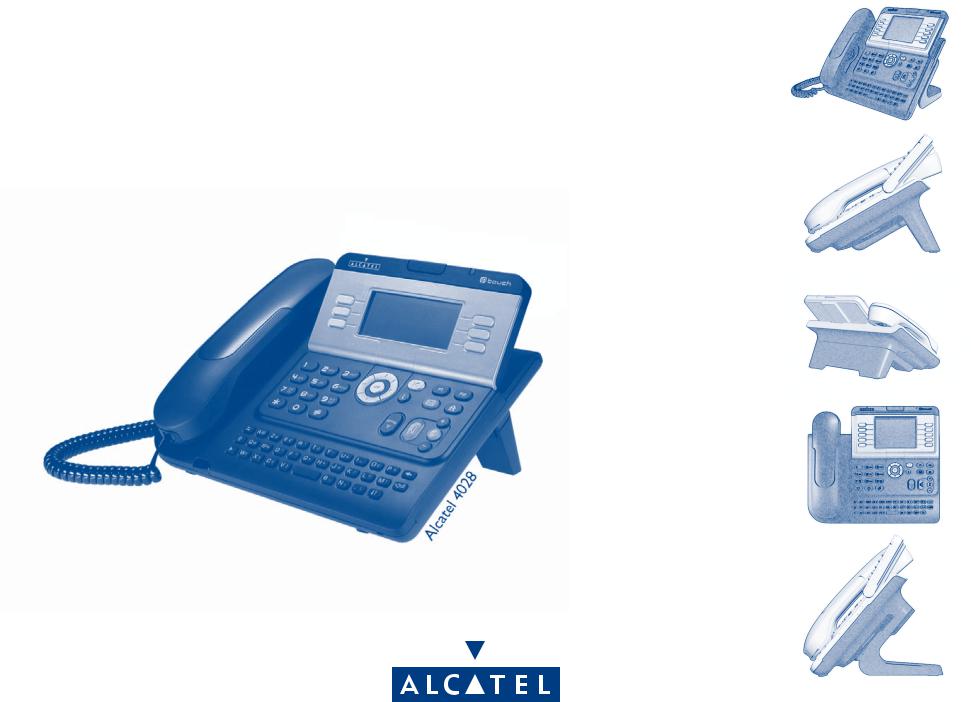
Alcatel OmniPCX Office
Alcatel 4028/4029
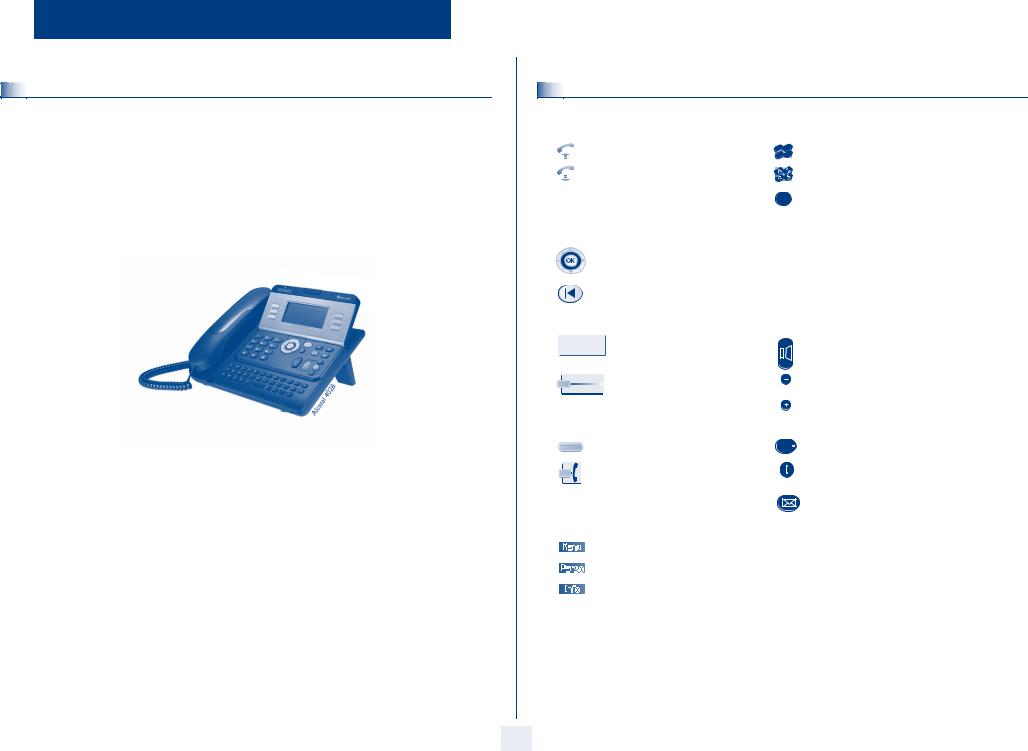
User manual
How
Introduction |
Thank you for choosing a 4028/4029 telephone manufactured by Alcatel.
Your 4028 (IP) or 4029 (digital) terminal has a new ergonomic layout for more effective communication.
A large graphic screen, in conjunction with various keys and the navigator, allows you to make calls, configure and program your telephone,
a receiver that is pleasant to use: it fits nicely in the hand with a flexible grip section,
communication is even more convenient using the audio keys (loudspeaker, hands free),
using the convenient alphabetic keypad, you can call your correspondents by name.
How to use this guide |
• Actions
Lift the receiver.
Hang up.
• Navigator
• Keypad
c |
def |
ab |
|
2 |
3 |
5 |
no |
6 |
|
jkl |
m |
2
Numeric keypad.
Alphabetic keypad.
Specific key on numeric keypad.
Move the navigation key up, down, to the left or to the right.
To go back one level (press and release) or to return to the welcome page (press and hold) ; during a conversation, can be used to access the different pages (Menu, Perso, etc.) and to return to the telephone screens.
• Display and display keys |
• Audio keys |
|
Smith John |
Partial view of display. |
Loudspeaker, |
|
hands free. |
|
… |
|
|
Display key. |
Adjustment “reduce”. |
|
|
|
Adjustment “increase”. |
• Programmable keys and icons |
• Other fixed keys |
|
|
Line key. |
Fixed key. |
|
Icon corresponding to key. |
MENU key. |
|
|
Voice mail access key. |
• Other symbols used
Means that the function is accessible from the Menu page.
Means that the function is accessible from the Perso page.
Means that the function is accessible from the Info page.














 Means that the function is subject to programming. If necessary, contact your installer. These symbols can be supplemented by small icons or text.
Means that the function is subject to programming. If necessary, contact your installer. These symbols can be supplemented by small icons or text.
3 |

1. |
2. |
3. |
4. |
Contents
Getting to know your telephone . . . . . . . . . . . . . . . . . . . . . . . . . . . . . . . . p.6 Description of the screens . . . . . . . . . . . . . . . . . . . . . . . . . . . . . . . . . . . . . p.7
1.1 Welcome screens . . . . . . . . . . . . . . . . . . . . . . . . . . . . . . . . . . . . . . . . . . . . . . . . . . . . . . . . p.7 1.2 Call management screen. . . . . . . . . . . . . . . . . . . . . . . . . . . . . . . . . . . . . . . . . . . . . . . . . . . p.8 1.3 Application screen . . . . . . . . . . . . . . . . . . . . . . . . . . . . . . . . . . . . . . . . . . . . . . . . . . . . . . . p.8
Using your telephone . . . . . . . . . . . . . . . . . . . . . . . . . . . . . . . . . . . . . . . . . p.9
2.1 Making a call . . . . . . . . . . . . . . . . . . . . . . . . . . . . . . . . . . . . . . . . . . . . . . . . . . . . . . . . . . . . p.9 2.2 Receiving a call . . . . . . . . . . . . . . . . . . . . . . . . . . . . . . . . . . . . . . . . . . . . . . . . . . . . . . . . . . p.9 2.3 Using the telephone in "Hands free" mode . . . . . . . . . . . . . . . . . . . . . . . . . . . . . . . . . . . . p.9 2.4 Activating the loudspeaker during a conversation (receiver lifted). . . . . . . . . . . . . . . . . . p.10 2.5 Calling your correspondent by name (company directory) . . . . . . . . . . . . . . . . . . . . . . . p.10 2.6 Make calls via your programmed call keys . . . . . . . . . . . . . . . . . . . . . . . . . . . . . . . . . . . . . p.10 2.7 Calling from the common directory . . . . . . . . . . . . . . . . . . . . . . . . . . . . . . . . . . . . . . . . . p.10 2.8 Filtering calls using the voice mailbox . . . . . . . . . . . . . . . . . . . . . . . . . . . . . . . . . . . . . . . . p.11 2.9 Redialling . . . . . . . . . . . . . . . . . . . . . . . . . . . . . . . . . . . . . . . . . . . . . . . . . . . . . . . . . . . . . . . p.11 2.10 Requesting automatic callback if internal number is busy . . . . . . . . . . . . . . . . . . . . . . . . . p.11 2.11 Answering an internal call in intercom mode . . . . . . . . . . . . . . . . . . . . . . . . . . . . . . . . . . p.11 2.12 Sending DTMF signals . . . . . . . . . . . . . . . . . . . . . . . . . . . . . . . . . . . . . . . . . . . . . . . . . . . . . p.12 2.13 Mute, so that your correspondent cannot hear you . . . . . . . . . . . . . . . . . . . . . . . . . . . . . p.12
During a conversation . . . . . . . . . . . . . . . . . . . . . . . . . . . . . . . . . . . . . . . . p.13
3.1 Making a second call during a conversation . . . . . . . . . . . . . . . . . . . . . . . . . . . . . . . . . . . . p.13 3.2 Answering a second call during a conversation . . . . . . . . . . . . . . . . . . . . . . . . . . . . . . . . . p.13 3.3 Switching between calls (Broker call). . . . . . . . . . . . . . . . . . . . . . . . . . . . . . . . . . . . . . . . . p.13 3.4 Transferring a call . . . . . . . . . . . . . . . . . . . . . . . . . . . . . . . . . . . . . . . . . . . . . . . . . . . . . . . . p.14 3.5 Three-way conference with internal and/or external correspondents (conference) . . . . p.14 3.6 Placing a call on hold (hold) . . . . . . . . . . . . . . . . . . . . . . . . . . . . . . . . . . . . . . . . . . . . . . . . p.14 3.7 Placing an outside call on hold (parking) . . . . . . . . . . . . . . . . . . . . . . . . . . . . . . . . . . . . . . p.15 3.8 Intrusion into an internal conversation . . . . . . . . . . . . . . . . . . . . . . . . . . . . . . . . . . . . . . . p.15 3.9 Store a number . . . . . . . . . . . . . . . . . . . . . . . . . . . . . . . . . . . . . . . . . . . . . . . . . . . . . . . . . . p.15 3.10 Adjust audio volume . . . . . . . . . . . . . . . . . . . . . . . . . . . . . . . . . . . . . . . . . . . . . . . . . . . . . . p.15
Sharing. . . . . . . . . . . . . . . . . . . . . . . . . . . . . . . . . . . . . . . . . . . . . . . . . . . . . p.16
4.1 Receiving supervised call ringing. . . . . . . . . . . . . . . . . . . . . . . . . . . . . . . . . . . . . . . . . . . . . p.16 4.2 Answering the general bell . . . . . . . . . . . . . . . . . . . . . . . . . . . . . . . . . . . . . . . . . . . . . . . . . p.16 4.3 Manager/secretary filtering . . . . . . . . . . . . . . . . . . . . . . . . . . . . . . . . . . . . . . . . . . . . . . . . . p.16 4.4 Call pick-up . . . . . . . . . . . . . . . . . . . . . . . . . . . . . . . . . . . . . . . . . . . . . . . . . . . . . . . . . . . . . p.16 4.5 Answering briefly in place of the operator . . . . . . . . . . . . . . . . . . . . . . . . . . . . . . . . . . . . p.17 4.6 Hunting groups . . . . . . . . . . . . . . . . . . . . . . . . . . . . . . . . . . . . . . . . . . . . . . . . . . . . . . . . . . p.17 4.7 Calling an internal correspondent on his/her pager . . . . . . . . . . . . . . . . . . . . . . . . . . . . . p.17 4.8 Answering a call on your pager . . . . . . . . . . . . . . . . . . . . . . . . . . . . . . . . . . . . . . . . . . . . . p.17 4.9 Calling a correspondent on his/her loudspeaker . . . . . . . . . . . . . . . . . . . . . . . . . . . . . . . . p.17 4.10 Sending a written message to an internal correspondent . . . . . . . . . . . . . . . . . . . . . . . . . p.18 4.11 Send a voice message copy. . . . . . . . . . . . . . . . . . . . . . . . . . . . . . . . . . . . . . . . . . . . . . . . . p.18 4.12 Sending a recorded message to a number / a distribution list . . . . . . . . . . . . . . . . . . . . . p.19 4.13 Broadcasting a message on the loudspeakers of a station group . . . . . . . . . . . . . . . . . . . p.19
5. |
6. |
7. |
Keep in touch. . . . . . . . . . . . . . . . . . . . . . . . . . . . . . . . . . . . . . . . . . . . . . . . p.20
5.1 Selecting calls to be diverted . . . . . . . . . . . . . . . . . . . . . . . . . . . . . . . . . . . . . . . . . . . . . . . p.20 5.2 Diverting calls to another number (immediate diversion). . . . . . . . . . . . . . . . . . . . . . . . . p.20 5.3 Diverting your calls to your voice message service . . . . . . . . . . . . . . . . . . . . . . . . . . . . . . p.20 5.4 When you return, consult recorded messages . . . . . . . . . . . . . . . . . . . . . . . . . . . . . . . . . p.20 5.5 Activate/disable the personal assistant . . . . . . . . . . . . . . . . . . . . . . . . . . . . . . . . . . . . . . . . p.21 5.6 Personal assistant: reaching you with one number only . . . . . . . . . . . . . . . . . . . . . . . . . . p.21 5.7 Diverting calls to your pager . . . . . . . . . . . . . . . . . . . . . . . . . . . . . . . . . . . . . . . . . . . . . . . p.21 5.8 Forwarding your calls from the receiving terminal (“Follow me”) . . . . . . . . . . . . . . . . . . p.21 5.9 Applying a selective diversion . . . . . . . . . . . . . . . . . . . . . . . . . . . . . . . . . . . . . . . . . . . . . . . p.21 5.10 Diverting all group calls. . . . . . . . . . . . . . . . . . . . . . . . . . . . . . . . . . . . . . . . . . . . . . . . . . . . p.21 5.11 Cancelling all diversions . . . . . . . . . . . . . . . . . . . . . . . . . . . . . . . . . . . . . . . . . . . . . . . . . . . p.22 5.12 Cancelling a specific diversion . . . . . . . . . . . . . . . . . . . . . . . . . . . . . . . . . . . . . . . . . . . . . . p.22 5.13 Diverting calls when your line is busy (divert if busy) . . . . . . . . . . . . . . . . . . . . . . . . . . . . p.22 5.14 Do not disturb . . . . . . . . . . . . . . . . . . . . . . . . . . . . . . . . . . . . . . . . . . . . . . . . . . . . . . . . . . p.22 5.15 Leaving a recorded message for internal callers . . . . . . . . . . . . . . . . . . . . . . . . . . . . . . . . p.22 5.16 Consulting written messages . . . . . . . . . . . . . . . . . . . . . . . . . . . . . . . . . . . . . . . . . . . . . . . p.23 5.17 Message notification . . . . . . . . . . . . . . . . . . . . . . . . . . . . . . . . . . . . . . . . . . . . . . . . . . . . . . p.23
Managing your charges . . . . . . . . . . . . . . . . . . . . . . . . . . . . . . . . . . . . . . . . p.24
6.1 Charging your calls directly to business accounts . . . . . . . . . . . . . . . . . . . . . . . . . . . . . . . p.24 6.2 Finding out the cost of an outside call made for an internal user from your terminal . . . p.24
Programming your telephone . . . . . . . . . . . . . . . . . . . . . . . . . . . . . . . . . . p.25
7.1 Initializing your voice mailbox. . . . . . . . . . . . . . . . . . . . . . . . . . . . . . . . . . . . . . . . . . . . . . . p.25 7.2 Customising your voice greeting . . . . . . . . . . . . . . . . . . . . . . . . . . . . . . . . . . . . . . . . . . . . p.25 7.3 Modifying your personal code . . . . . . . . . . . . . . . . . . . . . . . . . . . . . . . . . . . . . . . . . . . . . . p.25 7.4 Configuring the telephone ringer . . . . . . . . . . . . . . . . . . . . . . . . . . . . . . . . . . . . . . . . . . . . p.25 7.5 Adjusting screen brightness . . . . . . . . . . . . . . . . . . . . . . . . . . . . . . . . . . . . . . . . . . . . . . . . p.26 7.6 Selecting the welcome page . . . . . . . . . . . . . . . . . . . . . . . . . . . . . . . . . . . . . . . . . . . . . . . . p.26 7.7 Selecting language . . . . . . . . . . . . . . . . . . . . . . . . . . . . . . . . . . . . . . . . . . . . . . . . . . . . . . . . p.26 7.8 Programming direct call keys . . . . . . . . . . . . . . . . . . . . . . . . . . . . . . . . . . . . . . . . . . . . . . . p.26 7.9 Programming direct call keys . . . . . . . . . . . . . . . . . . . . . . . . . . . . . . . . . . . . . . . . . . . . . . . p.27 7.10 Programming an appointment reminder . . . . . . . . . . . . . . . . . . . . . . . . . . . . . . . . . . . . . . p.27 7.11 Identify the terminal you are on . . . . . . . . . . . . . . . . . . . . . . . . . . . . . . . . . . . . . . . . . . . . . p.27 7.12 Broadcasting background music on your loudspeaker . . . . . . . . . . . . . . . . . . . . . . . . . . . p.27 7.13 Lock / unlock your telephone. . . . . . . . . . . . . . . . . . . . . . . . . . . . . . . . . . . . . . . . . . . . . . . p.27 7.14 Configuring the audio jack of your telephone . . . . . . . . . . . . . . . . . . . . . . . . . . . . . . . . . . p.28 7.15 Activating/deactivating "forced headset" mode . . . . . . . . . . . . . . . . . . . . . . . . . . . . . . . . . p.28
Guarantee and clauses . . . . . . . . . . . . . . . . . . . . . . . . . . . . . . . . . . . . . . . . p.29
5 |
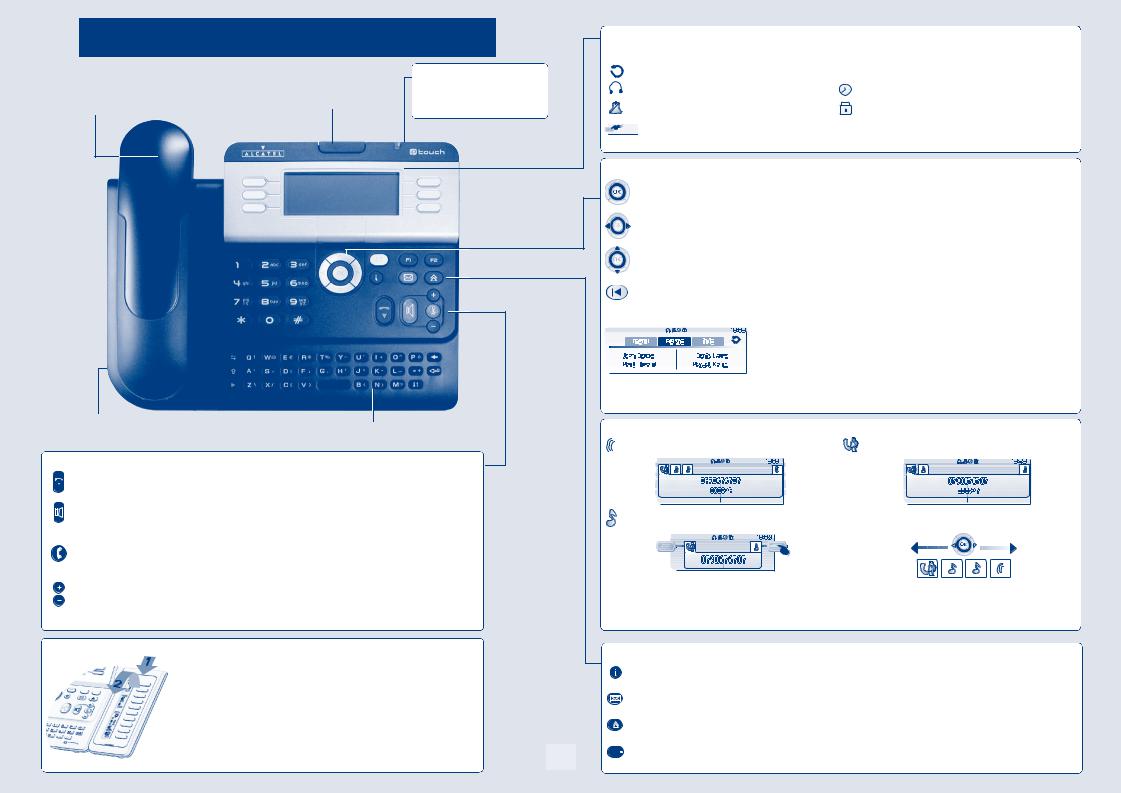
Getting to know your telephone
Telephone
Handset
Socket for connecting headphones or a
Hands-free / Loudspeaker unit
Audio keys
Hang-up key:; to terminate a call.
Indicator light
Adjust the tilt of the screen • Flashing green: incoming call.
• Flashing orange: alarm.
4028 Alcatel
Alphabetic keypad
Hands-free/Loudspeaker Key:to make or answer a call without lifting the receiver.
• Lit in hands-free mode or headset mode (short press).
•Flashing in loudspeaker mode (long press).
Intercom/Mute key:
• During a conversation: press this key so that your correspondent can no longer hear you.
•Terminal idle: press this key to answer calls automatically without picking up the receiver.
To adjust the loudspeaker or handset volume up or down
Extension unit
An extension unit can be fitted to your telephone. This provides additional keys which can be configured as function keys, line keys, call keys etc.
To affix labels: push the holding strip of the unit backwards to you and lift it. Install the label under the keypad, in the housing designed for, and place the keypad back into position.
6 |
Display and display keys
Contains several lines and pages providing information on calls and the functions accessible via the 6 keys associated with the words on the screen.
Transfer icon: pressing the key next to this icon allows you to program or change the transfer function.
Headset connected. |
Appointment programmed. |
Silent mode activated. |
Telephone locked. |
Display keys: pressing a display key activates the function shown associated with it on the screen.
Navigation
OK key: used to validate your choices and options while programming or configuring.
Left-right navigator: used to move from one page to another.
Up-down navigator: used to scroll through the content of a page.
Back/Exit key: to return to previous menu (short press) or return to first screen (long press) ; during a conversation, provides access to welcome screens (Menu, Info, ...) and to return to the conversation icon screens.
Welcome screens
Menu page: contains all functions and applications accessible via the keys associated with the words on the screen.
Perso page: contains call line keys (allowing supervision of calls) and programmable call keys.
Info page: contains information on the telephone and the status of its functions: name, telephone number, number of messages, activation of transfer function, appointment reminder, etc.
Call display
Incoming call.
Call on hold*.
If you get two calls at the same time, you can switch from one call to the other by pressing the display key associated with each call.
Function keys and programmable keys
Call in progress or outgoing call.
Left-right navigator: used to check calls.
Guide key: used to obtain information on functions of the 'menu' page and to program key of the 'perso' page.
Messaging key to access various mail services:
if the key flashes, a new voice message or a new text message has been received.
'Redial' key: to access the 'Redial' function.
Programmable key (F1 and F2 keys):
Lit when the function associated with the key is activated.
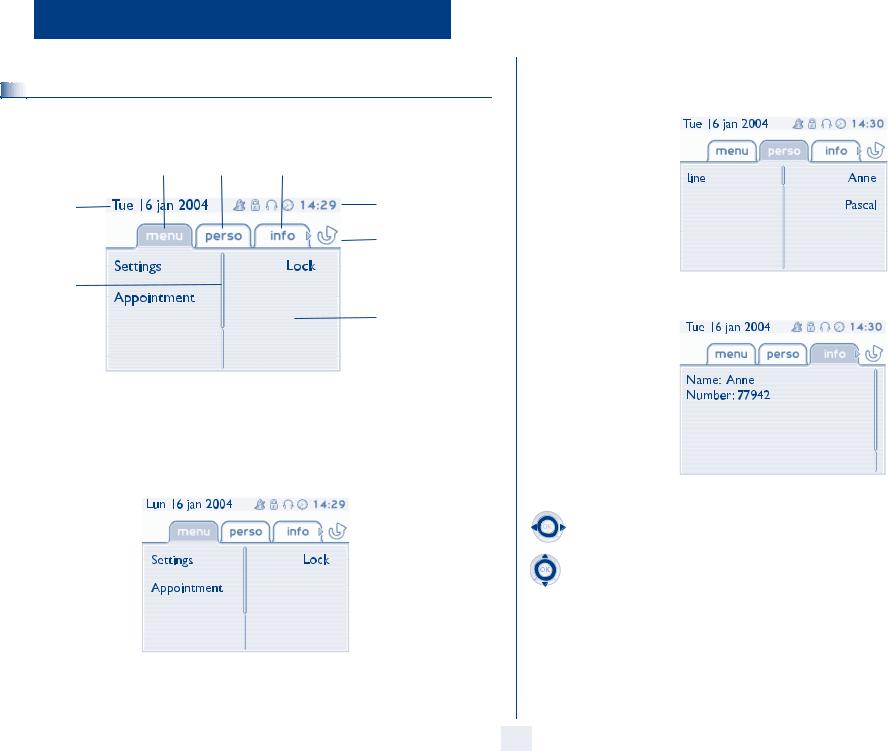
1Description of the screens
1.1 |
Welcome screens |
Menu page |
Perso page |
Info page |
Time and status icon
Date
Call forwarding icon Stationary: no forwarding activated.
Rotating: forwarding activated
Scroll bar: shows the position on a page
Displays the content of the page selected
Menu page: contains all functions and applications accessible via the keys associated with the words on the screen. From this page, it is possible to adjust the ringer volume and screen brightness, program the time of an appointment, lock the terminal, define the default page displayed, configure voice mail, and access telephone functions such as calling back one of the last 10 numbers or intercepting calls.
Perso page: contains call line keys (allowing supervision of calls) and programmable call keys. The up-down navigator is used to access all the direct call keys (apart from those displayed by default). Direct call keys are programmed or modified via the Information key.
Info page: contains information on the telephone and the status of its functions: name, telephone number, number of messages, activation of transfer function, appointment reminder, etc.
Left-right navigator:
used to move from one page to another.
Up-down navigator:
used to scroll through the content of a page.
7 |
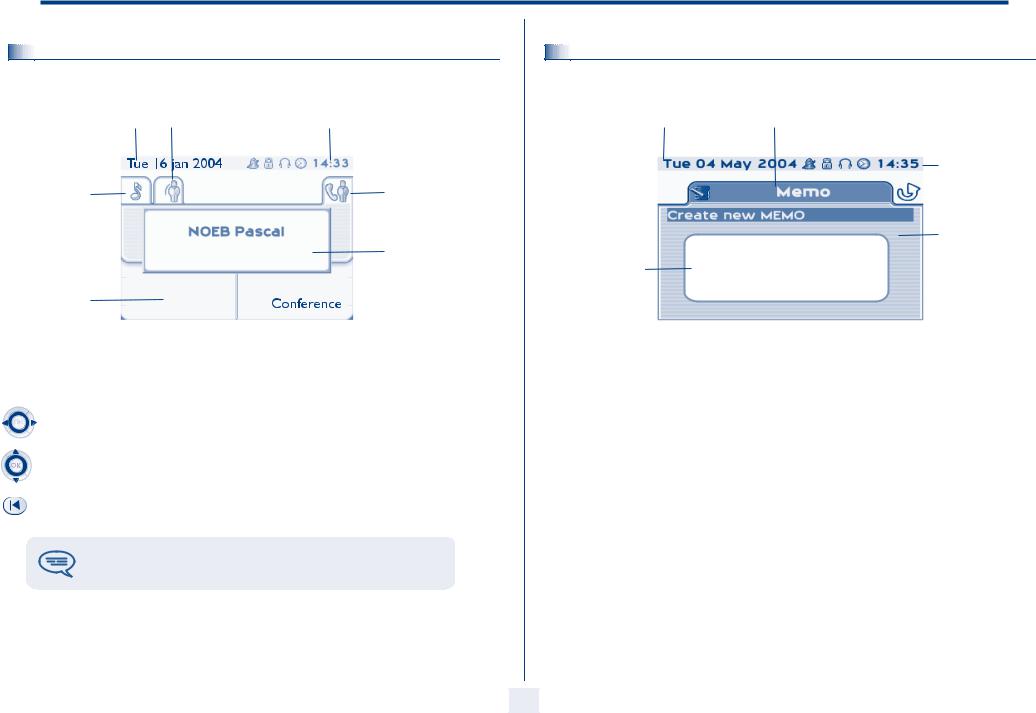
Description of the screens
1.2 |
Call management screen |
Date Incoming call icon |
Time and status icon |
Call holding icon
Pop-up display of functions accessible while the call is taking place
Call in progress icon
Incoming call presentation screen. This screen is temporarily displayed when a call arrives and shows the name and/or number of the caller.
Each tab corresponds to a call, the status of which is symbolized by its icon (in progress, held, arrival of new call). When a call is in progress, use the left-right navigator to look at held or incoming calls.
Use the up-down navigator to display the functions accessible. These functions (transfer, conference, etc.) are directly related to the status of the call consulted. For example, the transfer function will not be available between a call in progress or a held call and an incoming call.
Back/Exit key:
used to switch from a telephone screen to an application screen. For example, can be used while a call is in progress to look up a number, program an appointment reminder, etc.
Calls can also be managed from the Perso page.
While the call is in progress, press the Back/Exit key and display the Perso page.
Calls in progress or waiting are displayed on the different line keys. It is then possible to converse with the caller of your choice by pressing the key associated with him.
1.3 |
Application screen |
|
|
Date |
Application name |
Time and status icon
Application screen
Events screen
Application screen: displays information relevant to programming or configuring the telephone.
Events screen: displays events connected to the programming or configuration operations in progress, confirmation, rejection, error, etc.
8 |
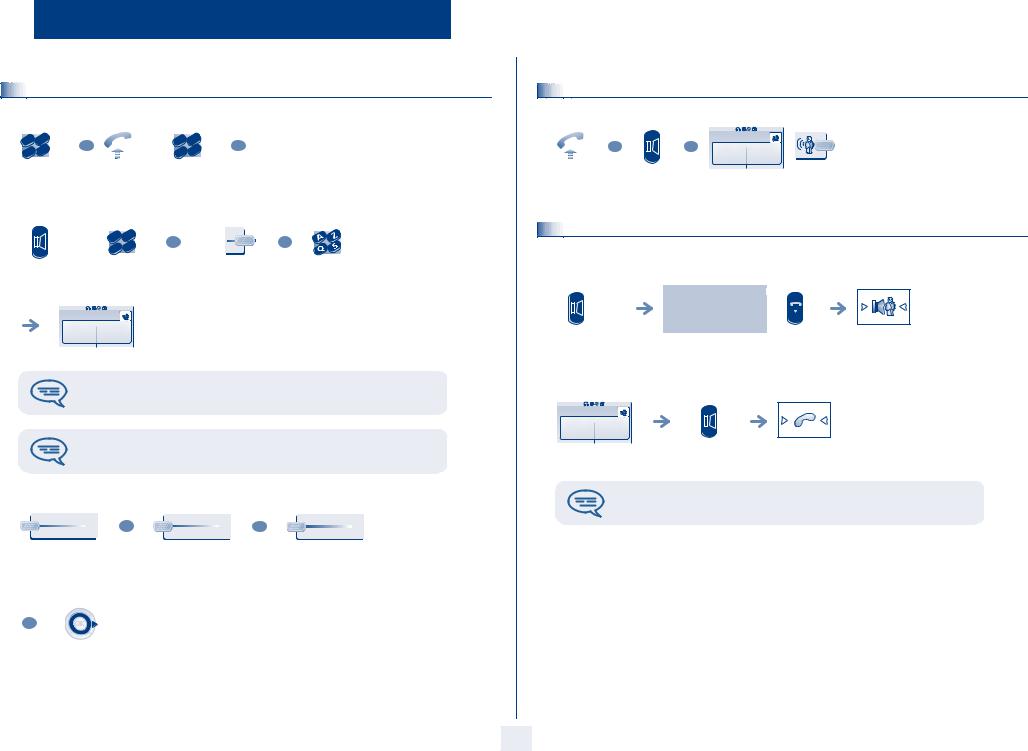
2 Using your telephone
2.1 |
Making a call |
c |
def |
|
|
c |
def |
|
|
ab |
|
|
ab |
|
|
||
2 |
3 |
OR |
|
2 |
3 |
OR |
|
|
o |
|
|
mno |
|
||
jkl |
mn |
|
|
jkl |
|
|
|
6 |
|
|
6 |
|
|
||
5 |
|
|
|
5 |
|
|
|
dial directly |
lift the |
number |
|
|
|||
the number |
receiver |
required |
|
|
|||
for your call |
|
|
|
|
|
|
|
|
|
c |
def |
|
|
|
|
|
|
ab |
|
|
|
|
|
|
|
2 |
3 |
OR |
|
|
OR |
|
|
|
n |
|
|
||
|
|
|
o |
|
|
|
|
|
|
jkl |
m |
|
|
|
|
|
|
6 |
|
|
|
|
|
|
|
5 |
|
|
|
|
|
hands free |
number |
|
programmed line |
correspondent’ |
|||
|
|
required |
|
|
key |
s name |
|
Paul |
in conversation |
during a conversation
To make an external call, dial the outside line access code before dialling your correspondent's number. 9 is the default code for an outside line.
For the operator, dial '0' (by default).
• If the internal or outside number does not reply:
Interphon |
¤Callback |
Text |
|
OR |
OR |
broadcast a message on |
request callback to a |
send a written |
the loudspeaker of the |
busy terminal |
message |
free terminal |
|
|
OR
go to next screen
2.2 |
Receiving a call |
OR |
OR |
|
Paul |
|
is calling |
lift the |
hands free |
press the key next to the |
receiver |
|
'incoming call' icon |
2.3 |
Using the telephone in 'Hands free' mode |
Terminal idle: |
|
press and release
Call in progress:
Paul |
in conversation |
during a conversation
you are in hands free mode
terminate your call
press and release
During a conversation, you can lift the receiver without terminating the call.
9 |
